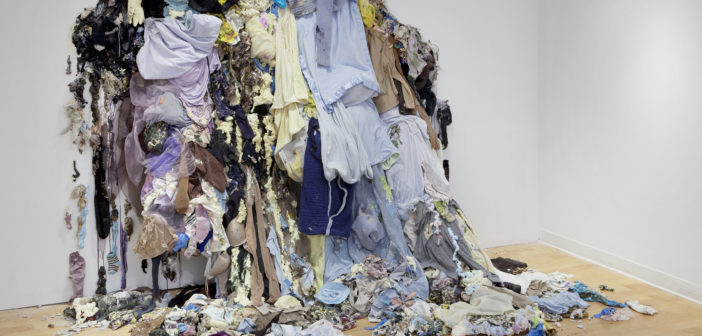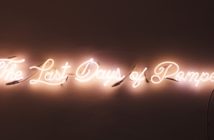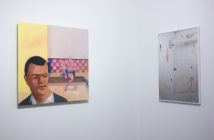Sarah Meyers Brent’s current exhibition, Growth and Decay, ought to—by the artist’s own admission—have been called Beautiful Mess. “Growth and decay” is a precise summation of how Brent’s assemblages and paintings, on view at Kingston Gallery through July 1, bulge and dribble in a palette of creams, olive greens, and bruise-like purples. But “beautiful mess” contains that additional kernel of wry humor buried in the heart of her work. It is also the title of the show’s largest, most recent and noteworthy piece.
Beautiful Mess, the artwork, lurks in Kingston’s central gallery. Hidden from the front gallery by a wall, it seems to pounce when visitors turn the corner. Beautiful Mess is a daunting assemblage of discarded laundry and other objects that Brent gathered from her own home and then arranged in her Somerville studio, adding splashes of paint, dribbles of spray foam, and her signature fake flowers. Secured into place with drywall, Beautiful Mess appears to erupt from the gallery wall before tumbling across the floor. In a studio visit, Brent explained that the work is partly about motherhood and partly an expression of anxiety about the environment. “This is what life feels like to me, right now,” she explains.
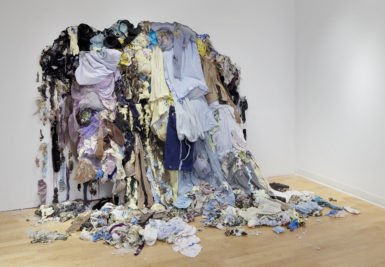
Sarah Meyers Brent, Beautiful Mess, 2017, fabric, acrylic, and mixed media on drywall, 144" x 120" x 75". Photo Credit: Will Howcroft Photography.
Yet all is not as chaotic as it seems. Beautiful Mess balances blocks of color. Lilacs lean to one side, while baby blues are gathered on the other. Black fabrics create contrast and depth along the drywall’s raw edge, and bright whites are scattered on the floor, drawing the eye downward. At first glance a total mess, Brent’s work is, in reality, meticulously orchestrated.
In fact, Beautiful Mess goes one step further by being site-specific. Initially, Brent had wanted to create the piece for her 2016 solo show at Danforth Art in Framingham, MA. When that space proved too wide for what she had envisioned, Brent waited until Kingston’s intimate center gallery was available. She took measurements and created sketches to make sure that everything fit perfectly. Due to the fragility of drywall, Beautiful Mess had a one-time shot at exhibition. Its presence at Kingston is the result of careful planning.
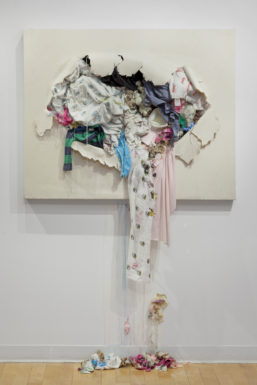
Sarah Meyers Brent, Mommy Loves Me III, 2017, fabric, acrylic, foam, mixed media on canvas, 77.5" x 50". Photo Credit: Will Howcroft Photography.
Similarly, there is more to Brent’s vision of motherhood than surface-level mess and anxiety. Take the Mommy Loves Me series in the front gallery. These pieces echo Beautiful Mess formally and thematically. Splitting open canvasses scarred with spray foam, the knots of laundry in Mommy Loves Me II and III are still chaotic, and even evoke the violence of birth more viscerally than Beautiful Mess. However, the cartoonish bumblebees, caterpillars and elephants festooning fabrics in Mommy Loves Me III are playful. Mommy Loves Me II is more somber in tone, but it, too, is tender. The sleeves that droop below the canvas’s edge look soft as well as tired and worn.
As a whole, Growth and Decay covers plenty of territory that will be familiar to those who saw Brent’s recent, albeit much smaller, solo show, Plant Monster, at Kingston. Luckily, Brent is a good curator of her own work, which keeps the presentation fresh. She manages a lively discussion among all pieces on view. Plant Monster VI, an acrylic study of a decomposing bouquet, looks suspiciously like a womb and ovaries when it shares a gallery with the Mommy Loves Me series. It’s perhaps no coincidence that it hangs next to Ooze, an undeniably phallic wall-mounted totem of paint shavings. Ooze III, a canvas supporting a seepage of spray foam, glitter and spiked paint, is exhibited in contrast to Beautiful Mess on the opposite wall. Where Beautiful Mess tumbles downward from the wall in a soft heap, the hard-edged materials in Ooze III bubble up from their support, or cling to it like a fungus. Some works even pull the gallery itself into play. In the front room, the centrally placed, floor-to-ceiling sculpture Ooze Pole is a thin pillar of paint shavings: dark, dirty, and deliciously textural. It also mimics the gallery’s overhead ducting, and easily assumes the role of architectural element itself.
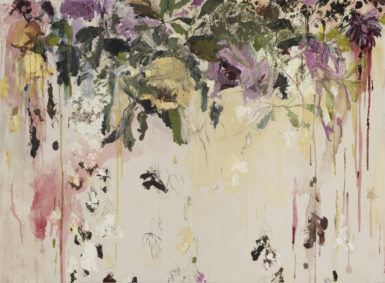
Sarah Meyers Brent, Dripping Plant III, 2017, acrylic on canvas, 48.5" x 66". Photo Credit: Will Howcroft Photography.
Growth and Decay is an exhibition that sprawls, but little appears out of place. Brent has a strong vocabulary of symbols and materials that lend variety to her works’ appearance without sacrificing unity of intention. Whether these works are ostensibly about motherhood, plant life, or the materiality of paint, they are all manifestations of Brent’s impulse to drag the grit of life into her studio, where it is reborn as art: messy and beautiful.

